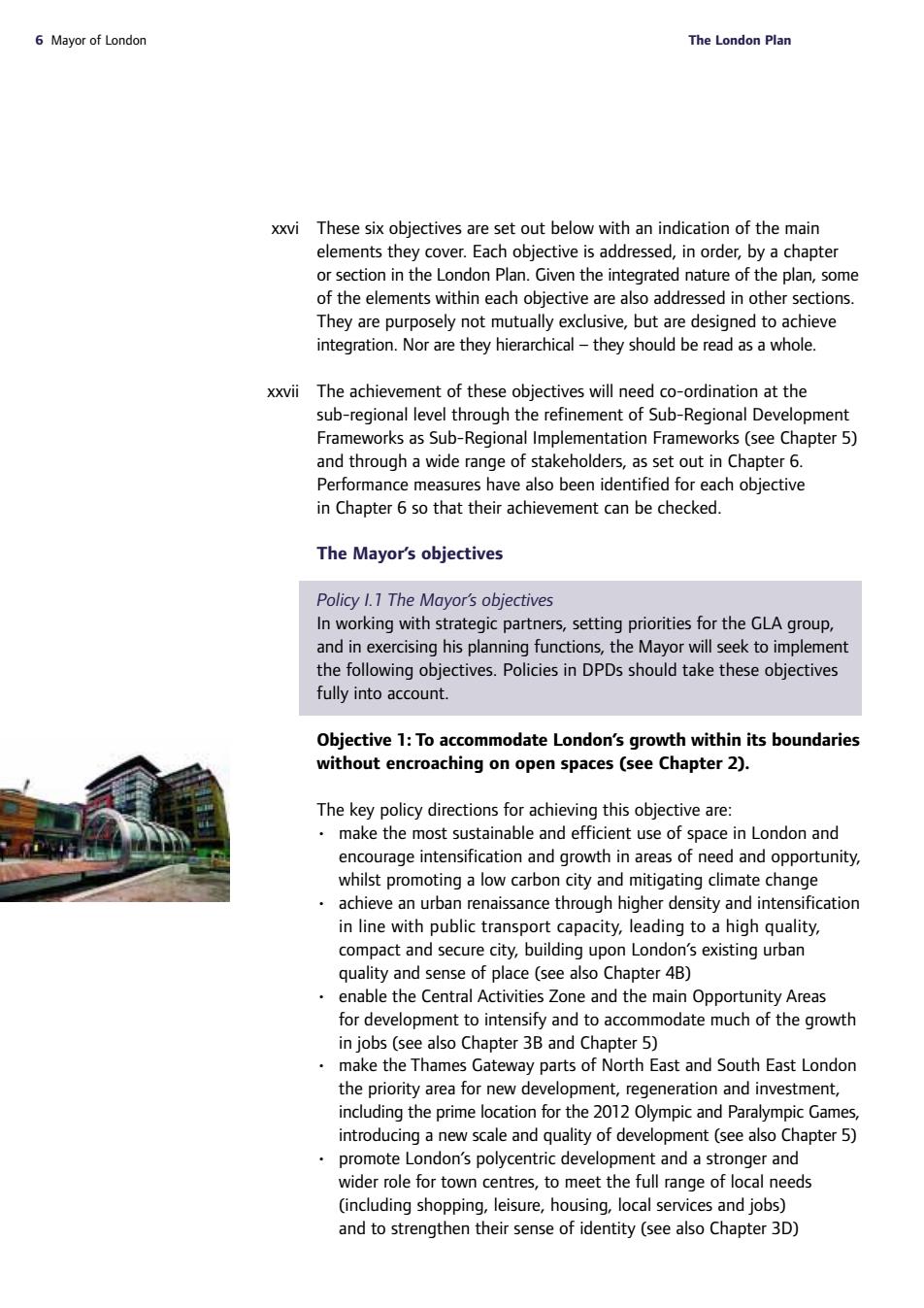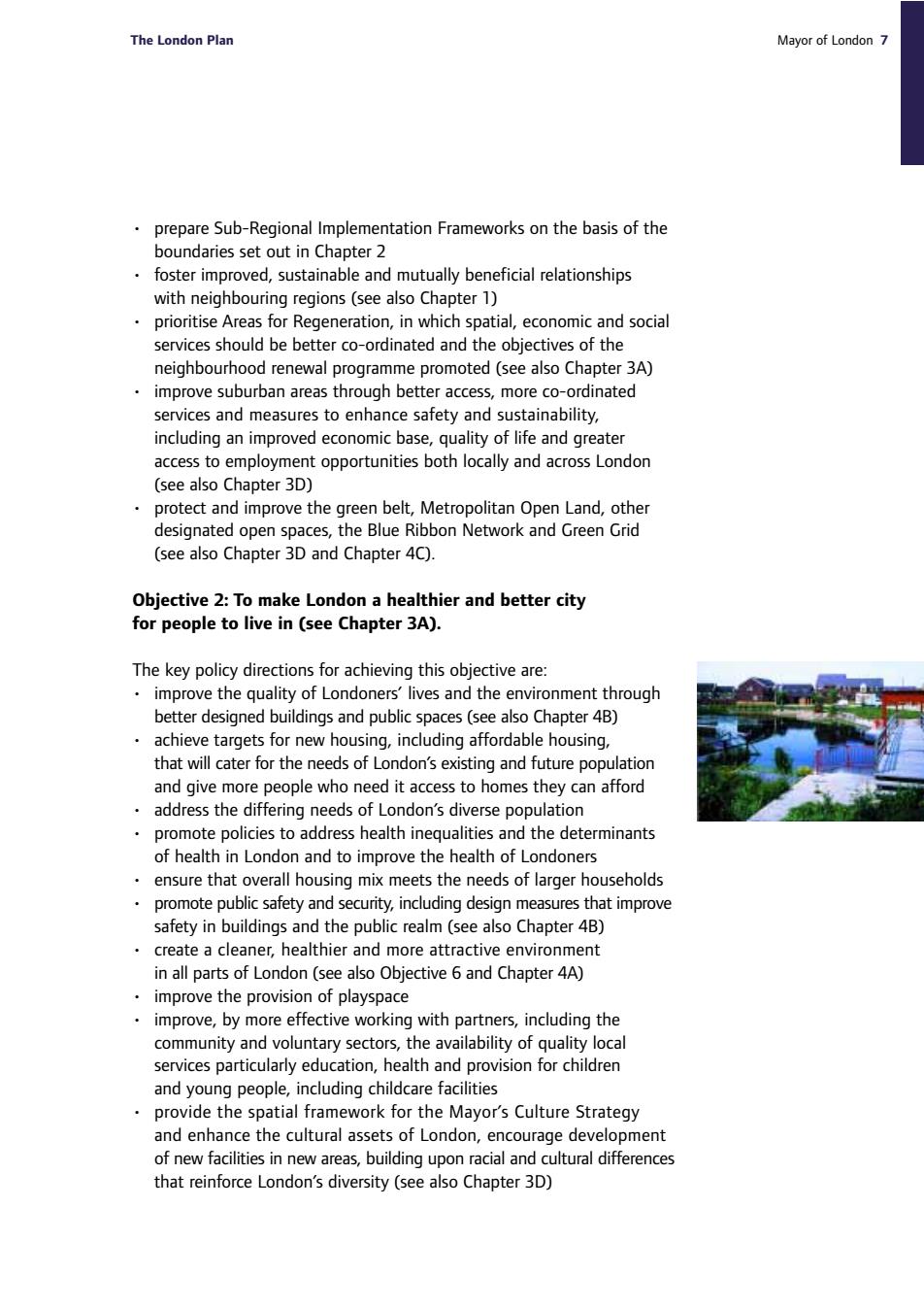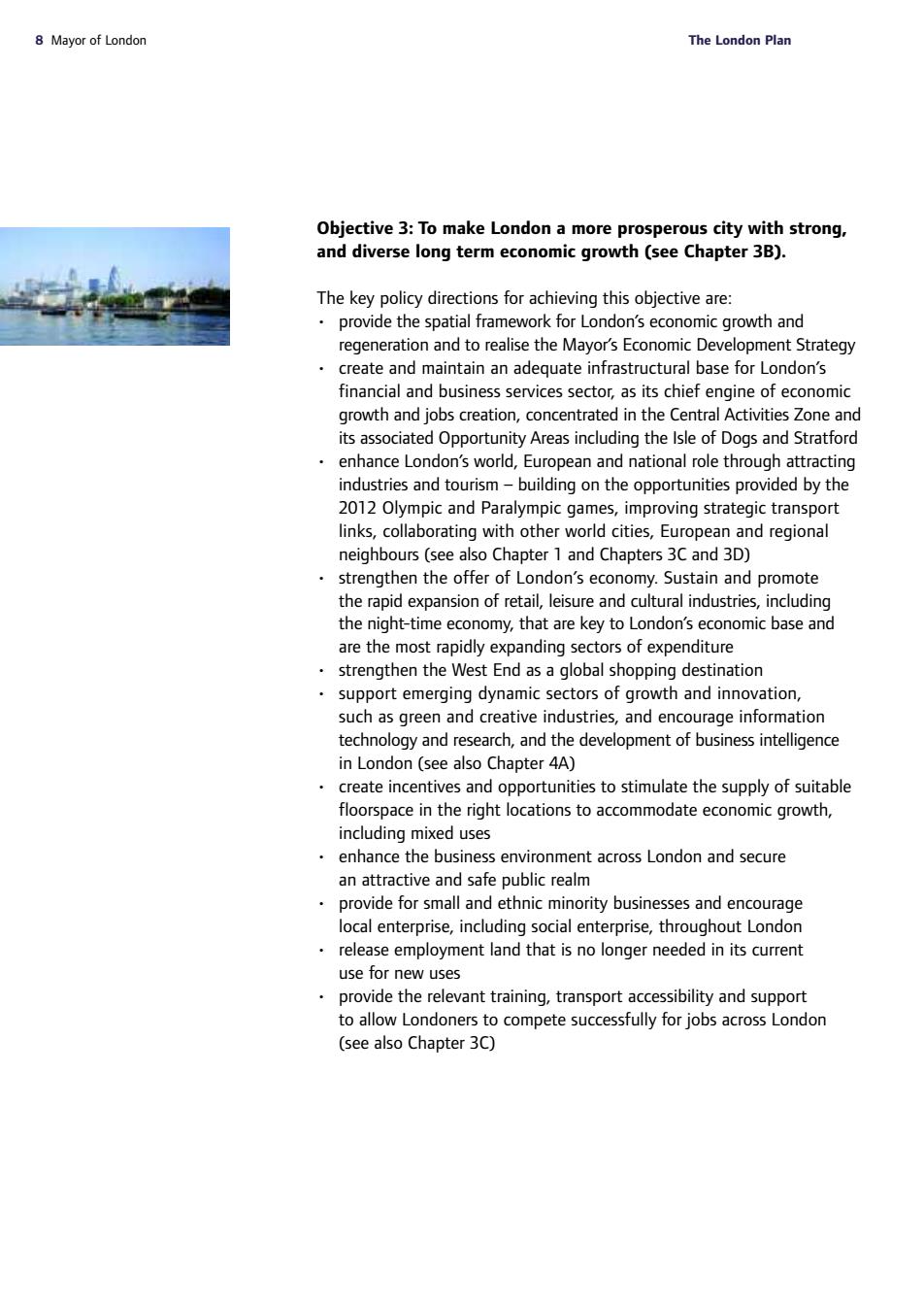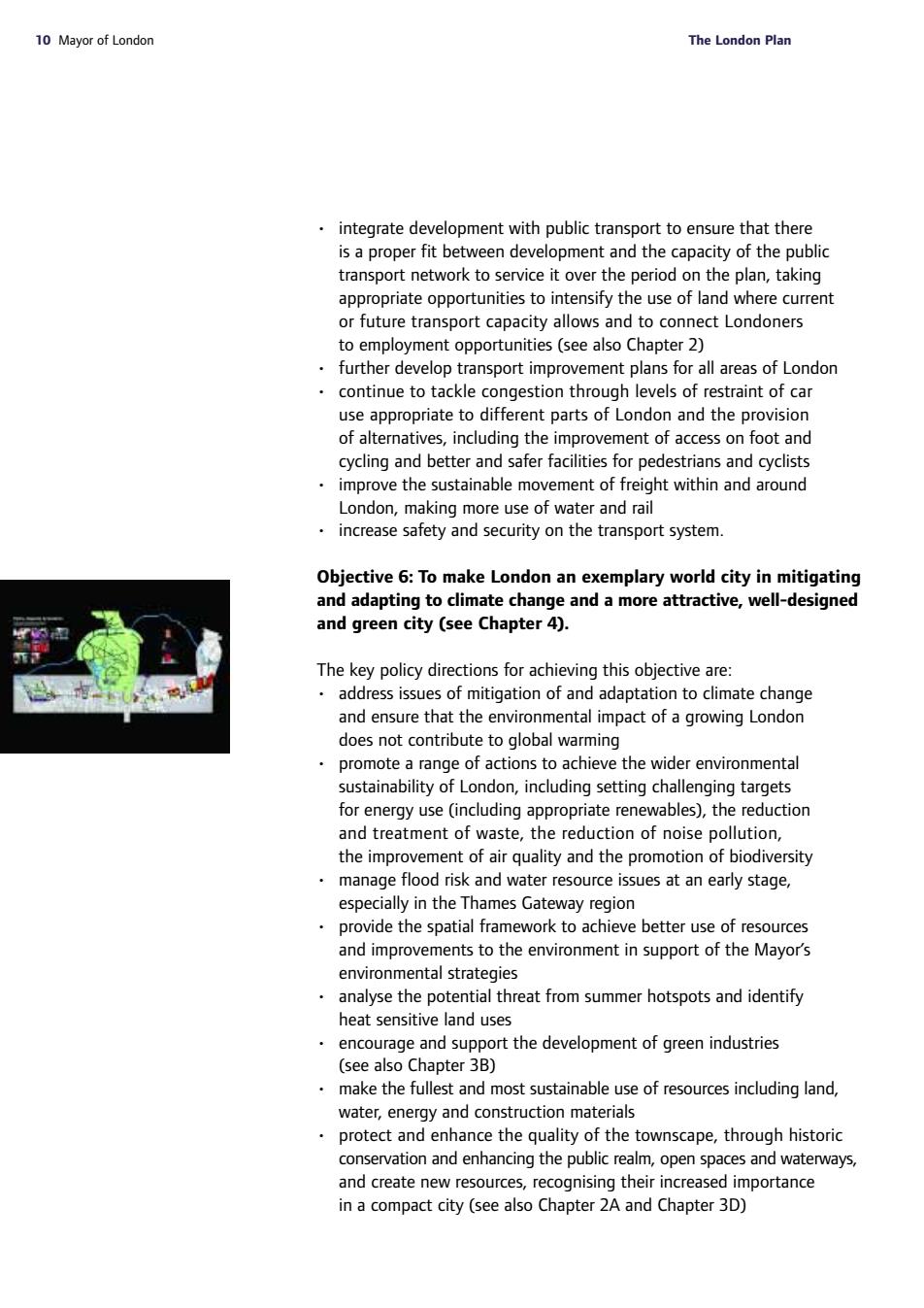
6Mayor of London The London Plar These six objectives are set out below with an indication of the main elements they cover.Each objective is addressed,in order,by a chapter or section in the London Plan.Given the integrated nature of the plan,some of the elements within each objective are also addressed in other sections. They are purposely not mutually exclusive,but are designed to achieve integration.Nor are they hierarchical-they should be read as a whole. xxvii The achievement of these objectives will need co-ordination at the sub-regional level through the refinement of Sub-Regional Developmen Fran ewo orks as Sub-Regional Im nentation Fra rks (see Cha apter 5) lders,a set out in Cha pter 6 mea nave also been identified for each objective in Chapter 6 so that their achievement can be checked. The Mayor's objectives Policy 1.1 The Mayor's objectives in working with strategic partners.setting priorities for the gla group and in exercising his planning functions the mavor will seek to implemen biectives.Policies in DPDs should take these objective fully into accoun Objective 1:To accommodate London's growth within its boundaries without encroaching on open spaces (see Chapter 2). The key policy directions for achieving this objective are: make the most sustainable and efficient use of space in London and encourage intensification and growth in areas of need and opportunity, whilst promoting a low carbon city and mitigating climate cha thr ouah hiaher der d int ompact a n's existing urba quality and sense of place (see also Chapter 4B) enable the Central Activities Zone and the main Opportunity Areas for development to intensify and to accommodate much of the growth in jobs (see also Chapter 3B and Chapter 5) make the Thames Gateway parts of North East and South East London the priority area for new development,regeneration and investment, including the prime location for the 2012 Olmpic and Paralympic games introducing a new scale and quality of develop ment (see also chapter 5) mote Lo polyc develo and a st ole for to wn ce ntres,to meet th eed (leisure, ices and jobs) and to strengthen their sense of identity (see also Chapter 3D)
6 Mayor of London The London Plan xxvi These six objectives are set out below with an indication of the main elements they cover. Each objective is addressed, in order, by a chapter or section in the London Plan. Given the integrated nature of the plan, some of the elements within each objective are also addressed in other sections. They are purposely not mutually exclusive, but are designed to achieve integration. Nor are they hierarchical – they should be read as a whole. xxvii The achievement of these objectives will need co-ordination at the sub-regional level through the refinement of Sub-Regional Development Frameworks as Sub-Regional Implementation Frameworks (see Chapter 5) and through a wide range of stakeholders, as set out in Chapter 6. Performance measures have also been identified for each objective in Chapter 6 so that their achievement can be checked. The Mayor’s objectives Policy I.1 The Mayor’s objectives In working with strategic partners, setting priorities for the GLA group, and in exercising his planning functions, the Mayor will seek to implement the following objectives. Policies in DPDs should take these objectives fully into account. Objective 1: To accommodate London’s growth within its boundaries without encroaching on open spaces (see Chapter 2). The key policy directions for achieving this objective are: • make the most sustainable and efficient use of space in London and encourage intensification and growth in areas of need and opportunity, whilst promoting a low carbon city and mitigating climate change • achieve an urban renaissance through higher density and intensification in line with public transport capacity, leading to a high quality, compact and secure city, building upon London’s existing urban quality and sense of place (see also Chapter 4B) • enable the Central Activities Zone and the main Opportunity Areas for development to intensify and to accommodate much of the growth in jobs (see also Chapter 3B and Chapter 5) • make the Thames Gateway parts of North East and South East London the priority area for new development, regeneration and investment, including the prime location for the 2012 Olympic and Paralympic Games, introducing a new scale and quality of development (see also Chapter 5) • promote London’s polycentric development and a stronger and wider role for town centres, to meet the full range of local needs (including shopping, leisure, housing, local services and jobs) and to strengthen their sense of identity (see also Chapter 3D)

The London Plan Mayor of London7 implementation Frameworks on the bais of the out in Chapter2 foster improved,sustainable and mutually beneficial relationships with neighbouring regions(see also Chapter 1) prioritise Areas for Regeneration,in which spatial,economic and social services should be better co-ordinated and the objectives of the neighbourhood renewal programme promoted (see also Chapter 3A) improve suburban areas through better access,more co-ordinated services and measures to enhance safety and sustainability including an im mic base quality of life and g eater ( opportunities both locally and across Londor designated (see also Chapter 3D and Chapter 40). Objective 2:To make London a healthier and better city for people to live in (see Chapter 3A). The key policy directions for achieving this objective are: uality of Londo rs'live build and the ment thro ngs and public dable pter 4B) fo new hous housing, that will cater for the needs of London's existing and future population and give more people who need it access to homes they can afford address the differing needs of London's diverse population promote policies to address health inequalities and the determinants of health in London and to improve the health of Londoners ensure that overall housing mix meets the needs of larger households promote publicsafety and security,incuding design measures that improve safety in building th realm(see also Chapter 4B) ctive environ ent also Objective 6and Chapter 4A) improve the provision of playspace improve,by more effective working with partners,including the community and voluntary sectors,the availability of quality local services particularly education.health and provision for children and young people,including childcare facilities provide the spatial framework for the Mayor's Culture Strategy and enhance the cultural assets of london.encourage develop ment of new facilities in new areas,building upon racial and cultural diffe that reinforce London's div ersity (see also Ch apter 3D)
The London Plan Mayor of London 7 • prepare Sub-Regional Implementation Frameworks on the basis of the boundaries set out in Chapter 2 • foster improved, sustainable and mutually beneficial relationships with neighbouring regions (see also Chapter 1) • prioritise Areas for Regeneration, in which spatial, economic and social services should be better co-ordinated and the objectives of the neighbourhood renewal programme promoted (see also Chapter 3A) • improve suburban areas through better access, more co-ordinated services and measures to enhance safety and sustainability, including an improved economic base, quality of life and greater access to employment opportunities both locally and across London (see also Chapter 3D) • protect and improve the green belt, Metropolitan Open Land, other designated open spaces, the Blue Ribbon Network and Green Grid (see also Chapter 3D and Chapter 4C). Objective 2: To make London a healthier and better city for people to live in (see Chapter 3A). The key policy directions for achieving this objective are: • improve the quality of Londoners’ lives and the environment through better designed buildings and public spaces (see also Chapter 4B) • achieve targets for new housing, including affordable housing, that will cater for the needs of London’s existing and future population and give more people who need it access to homes they can afford • address the differing needs of London’s diverse population • promote policies to address health inequalities and the determinants of health in London and to improve the health of Londoners • ensure that overall housing mix meets the needs of larger households • promote public safety and security, including design measures that improve safety in buildings and the public realm (see also Chapter 4B) • create a cleaner, healthier and more attractive environment in all parts of London (see also Objective 6 and Chapter 4A) • improve the provision of playspace • improve, by more effective working with partners, including the community and voluntary sectors, the availability of quality local services particularly education, health and provision for children and young people, including childcare facilities • provide the spatial framework for the Mayor’s Culture Strategy and enhance the cultural assets of London, encourage development of new facilities in new areas, building upon racial and cultural differences that reinforce London’s diversity (see also Chapter 3D)

8 Mayor of London The London Plar Objective 3:To make London a more prosperous city with strong. and diverse long term economic growth (see Chapter 3B) The key policy directions for achieving this objective are: provide the spatial framework for London's economic growth and regeneration and to realise the Mayor's Economic Development Strategy create and maintain an adequate infrastructural base for London's financial and business services sector.as its chief engine of economic owth and jobs creatio ,conce trated in the Central Activities Zon ciated reas inclu ogs and Str ratfo enhance Londor uropean an nat role through 2O2tSandtourtsm-btitngontheoppotuntiepiovdedbythe 2012 Olympic and Paralympic games,improving strategic transport links,collaborating with other world cities,European and regional neighbours(see also Chapter 1 and Chapters 3C and 3D) strengthen the offer of London's economy.Sustain and promote the rapid expansion of retail,leisure and cultural industries,including the night-time economy,that are key to London's economic base and are the most rapidly expanding sectors of expenditure ngthen the Wes End as alobal sho nation sup ort emerging dy such as green and crea ateino of gro th and inn atior ries,and enc rage inform on technology and research,and the e development of business intelligence in London (see also Chapter 4A) create incentives and opportunities to stimulate the supply of suitable floorspace in the right locations to accommodate economic growth, includina mixed uses enhance the business environment across London and secure an attractive and safe public realm small and ethni rity business s and enco th seemploymentlandthatisnolongerne, ed in its curren use for new uses provide the relevant training,transport accessibility and support to allow Londoners to compete successfully for jobs across London (see also Chapter 3C)
8 Mayor of London The London Plan Objective 3: To make London a more prosperous city with strong, and diverse long term economic growth (see Chapter 3B). The key policy directions for achieving this objective are: • provide the spatial framework for London’s economic growth and regeneration and to realise the Mayor’s Economic Development Strategy • create and maintain an adequate infrastructural base for London’s financial and business services sector, as its chief engine of economic growth and jobs creation, concentrated in the Central Activities Zone and its associated Opportunity Areas including the Isle of Dogs and Stratford • enhance London’s world, European and national role through attracting industries and tourism – building on the opportunities provided by the 2012 Olympic and Paralympic games, improving strategic transport links, collaborating with other world cities, European and regional neighbours (see also Chapter 1 and Chapters 3C and 3D) • strengthen the offer of London’s economy. Sustain and promote the rapid expansion of retail, leisure and cultural industries, including the night-time economy, that are key to London’s economic base and are the most rapidly expanding sectors of expenditure • strengthen the West End as a global shopping destination • support emerging dynamic sectors of growth and innovation, such as green and creative industries, and encourage information technology and research, and the development of business intelligence in London (see also Chapter 4A) • create incentives and opportunities to stimulate the supply of suitable floorspace in the right locations to accommodate economic growth, including mixed uses • enhance the business environment across London and secure an attractive and safe public realm • provide for small and ethnic minority businesses and encourage local enterprise, including social enterprise, throughout London • release employment land that is no longer needed in its current use for new uses • provide the relevant training, transport accessibility and support to allow Londoners to compete successfully for jobs across London (see also Chapter 3C)

The London Plan Mayor of London9 Objective 4:To note social inclusion and tackle deprivation and dis The key policy directions for achieving this objective are: tackle unemployment by increasing access to high quality jobs across London through training,advice and other support, particularly for those women and young people and minority ethnic groups most in need improve the provision of social infrastructure and related services playspaceand chilcare and ad nealth in from deprived area tackle concentrations of deprivation with the aim of ensuring that no one is seriously disadvantaged by where they live within 5-15 years (see also Chapter 2) tackle homelessness tackle discrimination building on the economic and cultural strenaths of London's diversity and building a London that is more accessible to disabled people (see also Chapter 4B) vork for the spatial policies and decisions of learning. and othe nd commu ensure that key so engaged in the development process. Objective 5:To improve London's accessibility (see Chapter 3C). The key policy directions for achieving this objective are: provide the spatial framework for the development of London's transport system and ensure that development supports the Mayor's Trar nd Lo and phased ondon's through increased es and infrastructure and secure the early completion of Crossrai strengthen measures to reduce CO2 emissions and the negative impacts of transport on air quality facilitate delivery of maior transport improvements needed for the 2012 Olympic and Paralympic games reduce the need to travel especially by car.and the growth of iourney lenaths ove intemational,national and regional transport accessto London including a sustainable and bal ad lo ndon area airport system
The London Plan Mayor of London 9 Objective 4: To promote social inclusion and tackle deprivation and discrimination (see Chapters 3A and 3B). The key policy directions for achieving this objective are: • tackle unemployment by increasing access to high quality jobs across London through training, advice and other support, particularly for those women and young people and minority ethnic groups most in need • improve the provision of social infrastructure and related services, including provision for health, playspace and childcare facilities and address health inequalities • ensure the legacy of the 2012 Olympic and Paralympic games increases access to facilities from deprived areas • tackle concentrations of deprivation with the aim of ensuring that no one is seriously disadvantaged by where they live within 5-15 years (see also Chapter 2) • tackle homelessness • tackle discrimination, building on the economic and cultural strengths of London’s diversity and building a London that is more accessible to disabled people (see also Chapter 4B) • provide a framework for the spatial policies and decisions of learning, health, safety and other key social and community services • ensure that all Londoners benefit from economic growth and are engaged in the development process. Objective 5: To improve London’s accessibility (see Chapter 3C). The key policy directions for achieving this objective are: • provide the spatial framework for the development of London’s transport system and ensure that development supports the Mayor’s Transport Strategy • improve and expand London’s public transport through increased and phased investment in services and infrastructure and secure the early completion of Crossrail • strengthen measures to reduce CO2 emissions and the negative impacts of transport on air quality • facilitate delivery of major transport improvements needed for the 2012 Olympic and Paralympic games • reduce the need to travel especially by car, and the growth of journey lengths • improve international, national and regional transport access to London, including a sustainable and balanced London area airport system

10 Mayor of London The London Plar is a proper fit between development and the capacity of the public transport network to service it over the period on the plan,taking appropriate opportunities to intensify the use of land where current or future transport capacity allows and to connect Londoners to employment opportunities (see also Chapter 2) further develop transport improvement plans for all areas of London continue to tackle congestion through levels of restraint of car use appropriate to different parts of London and the provision of alte foot ar cycling and be t ieighitthnandaCUnd London,making more use of water and rail increase safety and security on the transport system. Objective 6:To make London an exemplary world city in mitigating and adapting to climate change and a more attractive,well-designed and green city (see Chapter 4). address iss es of mitig on to cl ate e chang and ensure that the envi mental impact of does not contribute to global warming promote a range of actions to achieve the wider environmental sustainability of London,including setting challenging targets for energy use(including appropriate renewables),the reduction and treatment of waste,the reduction of noise pollution, the improvement of air quality and the promotion of biodiversity manage flood risk and water resource issues at an early stage, mes Cateu pro vide the spatial fr and improve environmental strategies analyse the potential threat from summer hotspots and identify heat sensitive land uses encourage and support the development of green industries (see also chapter 3B) make the fullest and most sustainable use of resources including land, water.energy and construction materials ionand ing the public ,open sp and create and e ne portance in a compact city(see also Chapter 2A and Chapter 3D
10 Mayor of London The London Plan • integrate development with public transport to ensure that there is a proper fit between development and the capacity of the public transport network to service it over the period on the plan, taking appropriate opportunities to intensify the use of land where current or future transport capacity allows and to connect Londoners to employment opportunities (see also Chapter 2) • further develop transport improvement plans for all areas of London • continue to tackle congestion through levels of restraint of car use appropriate to different parts of London and the provision of alternatives, including the improvement of access on foot and cycling and better and safer facilities for pedestrians and cyclists • improve the sustainable movement of freight within and around London, making more use of water and rail • increase safety and security on the transport system. Objective 6: To make London an exemplary world city in mitigating and adapting to climate change and a more attractive, well-designed and green city (see Chapter 4). The key policy directions for achieving this objective are: • address issues of mitigation of and adaptation to climate change and ensure that the environmental impact of a growing London does not contribute to global warming • promote a range of actions to achieve the wider environmental sustainability of London, including setting challenging targets for energy use (including appropriate renewables), the reduction and treatment of waste, the reduction of noise pollution, the improvement of air quality and the promotion of biodiversity • manage flood risk and water resource issues at an early stage, especially in the Thames Gateway region • provide the spatial framework to achieve better use of resources and improvements to the environment in support of the Mayor’s environmental strategies • analyse the potential threat from summer hotspots and identify heat sensitive land uses • encourage and support the development of green industries (see also Chapter 3B) • make the fullest and most sustainable use of resources including land, water, energy and construction materials • protect and enhance the quality of the townscape, through historic conservation and enhancing the public realm, open spaces and waterways, and create new resources, recognising their increased importance in a compact city (see also Chapter 2A and Chapter 3D)